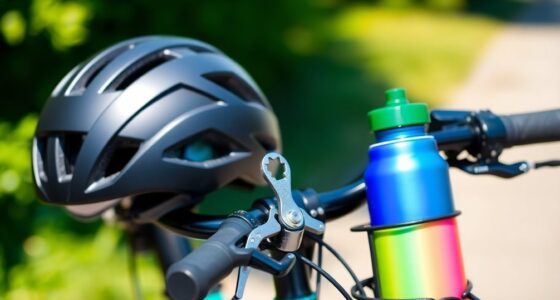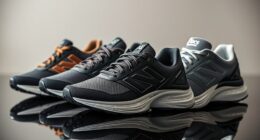To choose the right bike bags for your cycling trip, start by identifying the type of trip you're taking—short rides may need saddle bags, while longer adventures benefit from panniers. Consider key features like durability, weather resistance, and secure attachment systems. Evaluate your storage capacity based on the gear you need to bring, and make sure weight distribution keeps your bike balanced. Interested in more tips on specific bag types and brands? There's plenty more to explore!
Key Takeaways
- Assess your trip duration to determine storage needs; short trips may only require saddle bags, while longer journeys need larger panniers or bikepacking bags.
- Prioritize durability and weather resistance by choosing bags made from high-quality nylon or polyester with reinforced stitching and waterproof features.
- Evaluate the attachment system, ensuring compatibility with your bike and selecting secure options like Velcro straps or quick-release clips for stability.
- Balance weight distribution by packing heavier items low and centered in panniers or frame bags to enhance bike handling and stability.
- Check maximum weight limits for each bag type to ensure safe transport of your gear without compromising bike performance.
Understanding the Different Types of Bike Bags
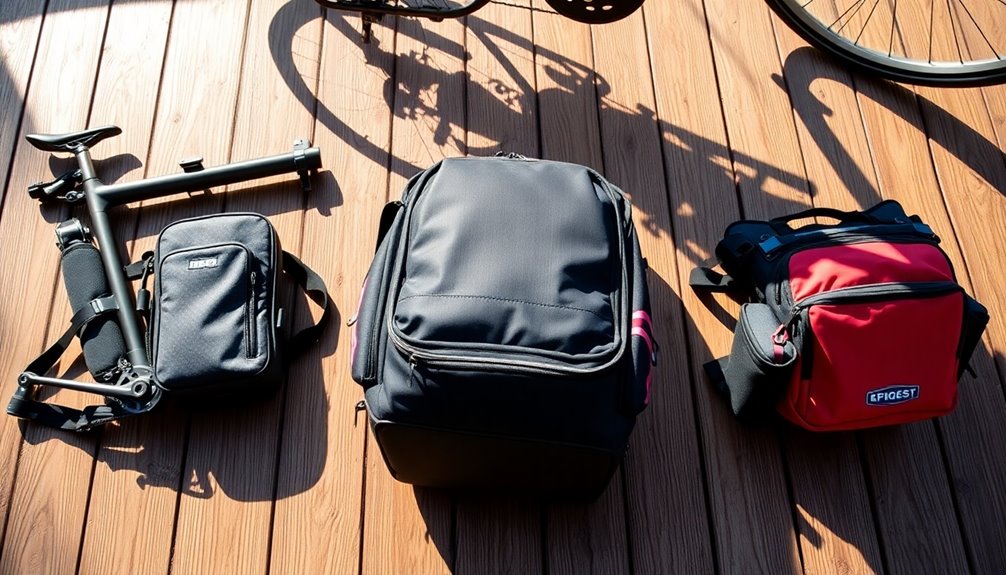
When you're gearing up for a cycling trip, understanding the different types of bike bags can make all the difference in your ride.
Saddle bags are compact and attach under your seat, perfect for carrying essentials like tools and snacks.
Saddle bags offer a compact solution for essential tools and snacks, conveniently attaching under your seat for easy access.
For quick access, handlebar bags are your best bet, letting you grab snacks or cameras effortlessly.
Frame bags fit snugly within your bike's frame, offering versatile storage space for both short trips and long rides.
If you need more extensive capacity, panniers and cycling backpacks provide ample room for larger gear.
Top tube bags are great for small items, allowing for easy access without stopping.
Look for bags made from waterproof fabric to keep your gear dry, enhancing your bikepacking experience.
Key Features to Consider When Selecting Bike Bags
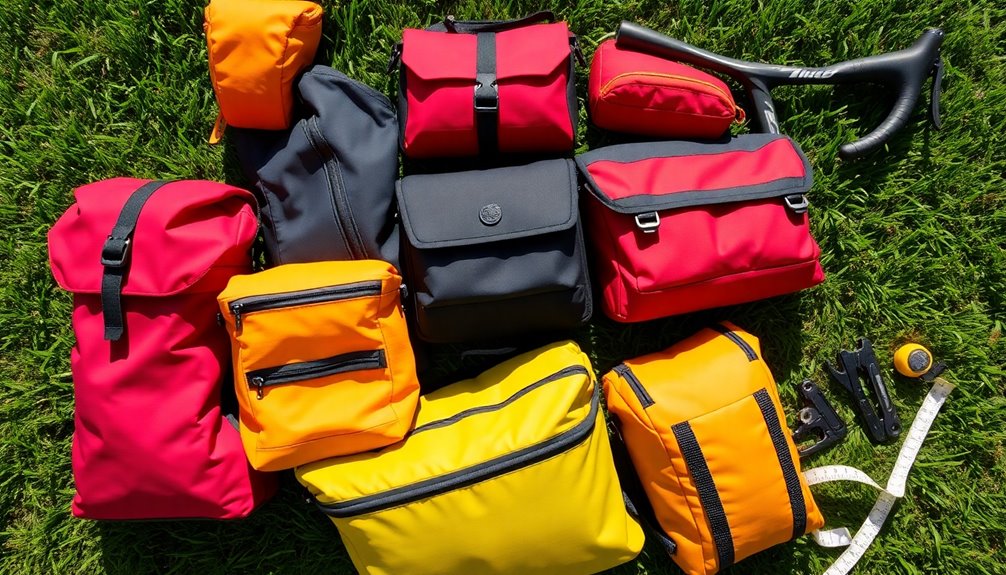
Selecting the right bike bag involves considering several key features to guarantee it meets your needs on the road.
Here are four essential aspects to keep in mind:
- Durability: Look for bike bags made from high-quality nylon or polyester to withstand wear and tear during your cycling trips.
- Attachment Systems: Choose bags with secure, easy-to-attach systems like Velcro straps or quick-release clips for stability.
- Weatherproof Capabilities: Make sure your bag has waterproof materials or sealed seams to protect contents from rain and moisture.
- Weight Distribution: Properly packed bags should balance heavier items low and centered to maintain peak bike handling and stability.
Evaluating Storage Capacity for Your Needs

Finding the right bike bag goes beyond just checking durability and attachment systems; you'll also want to evaluate its storage capacity based on your specific needs.
For short cycling trips, a saddle bag with 5-10 liters might suffice. However, if you're planning multi-day adventures, consider larger panniers or bikepacking bags with capacities of 15-40 liters or more.
Assess the type of gear you'll carry; essential tools fit well in a handlebar bag, while camping gear may need a larger frame pack or rear panniers.
Consider your gear needs: essential tools work in a handlebar bag, while camping gear requires larger packs or rear panniers.
Always keep weight distribution in mind—heavier items should sit lower for stability.
Finally, check the maximum weight limits of your bags, as panniers can typically handle 20-50 lbs, ensuring you carry gear safely on your journey.
Assessing Durability and Weather Resistance
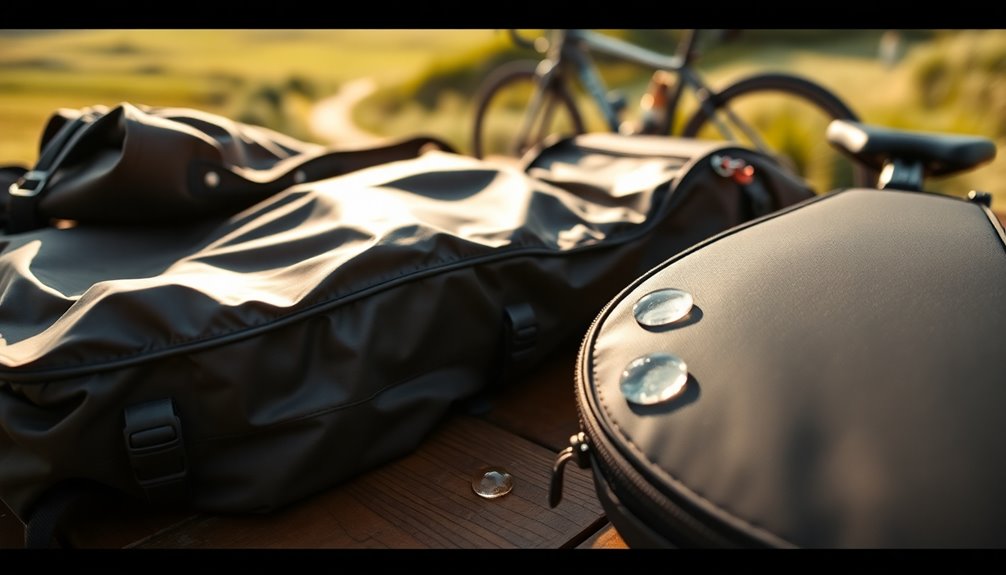
When you're choosing bike bags, material quality is key for durability and resistance to wear.
You'll want to look for waterproof features to keep your gear safe from rain and moisture.
Testing the weather resistance of your bags guarantees they can handle whatever Mother Nature throws your way.
Material Quality Importance
Durability and weather resistance are essential factors to evaluate in bike bags, as these qualities directly impact your gear's protection during cycling trips.
When choosing your bike bags, consider the following:
- Material Quality: Opt for durable materials like nylon or polyester for increased wear resistance.
- Reinforced Stitching: Look for bags with reinforced stitching and weatherproof zippers to enhance longevity.
- Weight vs. Strength: Remember that heavier bags often offer more robust protection, while lighter options may sacrifice durability.
- Maintenance: Regular cleaning and upkeep can greatly extend your bike bags' lifespan and maintain material quality.
Additionally, consider how user-friendly installation can influence your decision, as some bags may come with features that simplify attachment to your bike.
Waterproof Features Essential
After evaluating material quality, the next factor to prioritize is waterproof features. These features are essential for bike bags, ensuring your gear stays dry during unpredictable weather.
Look for bags with high water resistance, rubberized materials, and waterproof coatings that enhance durability. Sealed seams and water-resistant zippers are necessary, as they greatly reduce the risk of water ingress, especially in heavy downpours.
Investing in high-quality bags with these waterproof features not only offers moisture protection but also safeguards your electronics and essentials. This is critical for multi-day cycling trips or when facing adverse weather conditions.
Weather Resistance Testing Methods
Understanding how bike bags hold up against the elements is vital for any cyclist planning a trip. To guarantee you choose the right bag, look for these key weather resistance testing methods:
- Water Column Tests: Measures how much water pressure the fabric withstands; higher numbers mean better waterproofing.
- Abrasion Resistance: Assesses how well the material resists wear and tear, essential for long-term durability.
- Seam Sealing Techniques: Taped seams prevent water penetration, enhancing waterproofing.
- UV Resistance Testing: Confirms materials don't degrade under sunlight, maintaining their protective qualities.
Real-world testing in various cycling scenarios also reveals how bags perform in rain or snow, highlighting their overall weather resistance and durability.
Choose wisely!
Choosing the Right Attachment Systems

When you're gearing up for a cycling trip, choosing the right attachment system for your bike bags can make all the difference in your ride.
The various attachment systems, like Velcro straps, quick-release clips, and cam buckles, offer different benefits. For panniers, spring-loaded hooks guarantee a secure attachment to racks, preventing any shifting during your ride.
Handlebar bags need systems that avoid interference with brake cables and maintain clearance from the front tire for safe handling. If you prefer frame packs or top tube bags, look for Velcro or strap-based systems that allow quick attachment while keeping a low profile.
Always check compatibility with your bike's design to avoid any detachment issues on your adventure.
Popular Bike Bags for Every Type of Cyclist
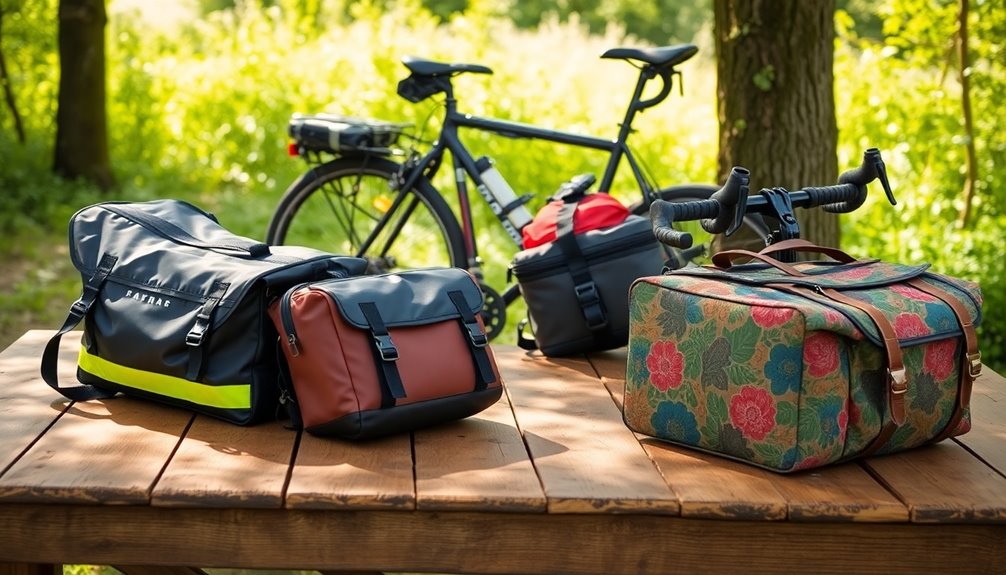
Finding the right attachment system for your bike bags sets the stage for selecting the best bags to suit your cycling needs.
Here are some popular bike bags for every type of cyclist:
- Saddle Bags: Compact and easy to use, perfect for short trips, holding essentials like tools and snacks.
- Handlebar Bags: Offer quick access with storage capacities up to 10L, great for snacks or cameras.
- Frame Bags: Ideal for long trips, these bags maintain bike stability while accommodating necessary gear.
- Panniers: With extensive storage capacity (20-40 liters), these bags are perfect for touring cyclists and easily attach to rear racks.
Choose the right bags based on your trip length and storage needs to enhance your cycling experience!
Frequently Asked Questions
What Type of Bag Is Best for Cycling?
When you're gearing up for a ride, choosing the right bag can feel like picking a favorite candy—each has its charm!
Saddle bags are great for essentials, keeping things light and easy. If quick access is your jam, consider a handlebar bag for snacks or your camera.
For longer adventures, panniers offer ample space. Just remember, waterproof features are your best friend against those unexpected showers—keeping your gear safe and sound!
How to Choose a Bike Frame Bag?
When you're choosing a bike frame bag, start by measuring your bike's frame size and shape to find a snug fit.
Look for waterproof materials and sealed zippers to keep your gear dry.
Multiple compartments help you organize snacks and tools easily.
Make certain the attachment system is secure yet easy to remove, and consider the bag's capacity based on your trip length to guarantee you maintain bike stability.
How to Pack a Bike for Touring?
When you're packing your bike for touring, start by carefully clearing components. Remove the pedals, deflate the tires, and detach the wheels to create compactness.
Next, you'll want to eliminate the seatpost, saddle, and handlebar to minimize size.
Don't forget to delicately detach the rear derailleur while keeping it attached to the chain.
Securely stow everything and pack essential tools for a swift setup upon arrival at your destination.
What Is the Difference Between Saddle Bags and Panniers?
Saddle bags and panniers serve different purposes for cyclists.
Saddle bags, mounted under your seat, are compact and perfect for essentials like tools and snacks on short rides.
Panniers, attached to bike racks, offer much larger storage—ideal for longer trips.
While saddle bags are lighter and easier to attach, they can sway if overloaded.
Panniers provide more stability and are better for carrying heavier loads, making them versatile for multi-day adventures.
Conclusion
Choosing the right bike bags can feel like finding the perfect key to access your cycling adventure. Whether you're packing for a weekend escape or a cross-country journey, remember that the right bag can lighten your load and elevate your experience. By considering the types, features, and durability, you'll ride with confidence, knowing your gear is secure and accessible. So saddle up, and let your bike bags be the trusty companions that carry your dreams on every pedal stroke!



